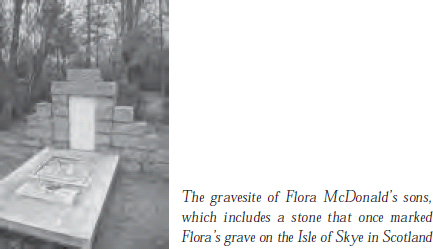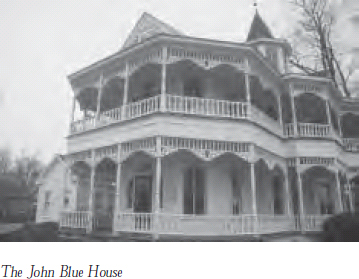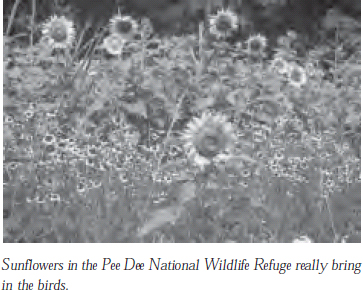
Ellerbe, Rockingham, Hamlet, Laurinburg, Pembroke
Most people would probably agree that other parts of North Carolina are better known for their travel opportunities. Yet if you like getting off the well-beaten path, or if you take pride in chasing tiny details and one-of-a-kind experiences, you’ll find something to like in the southeastern towns—Rockingham, Hamlet, Laurinburg, Pembroke, Lumberton—that sit along the North Carolina-South Carolina border.
What kinds of tiny details am I talking about here? Well, Civil War buffs who think they’ve seen it all may want to visit the Scottish church where Sherman’s men scrawled their names. Scottish folks and those who’d like to be might spend some time in Laurinburg and Scotland County. People interested in Native American history can stay busy visiting several area museums. Jazz lovers may want to visit the birthplace of John Coltrane and see the school Dizzy Gillespie attended. Natural-history lovers won’t want to miss the Rankin Museum in Ellerbe. Bird watchers will enjoy spotting their feathered friends at Pee Dee National Wildlife Refuge.
Where to Stay
The Ellerbe Springs Inn and Restaurant (800-248-6467 or 910-652-5600; www.ellerbesprings.com) in Ellerbe is superbly gracious, and a stay here is ultra-relaxing. Otherwise, you can choose among the chain motels in the area. If you don’t stay at the Ellerbe Springs Inn, at least dine there. The fried chicken is hard to beat. Plus, during the season, you’ll be close to peach orchards galore!
Where to Eat
Chain restaurants predominate in this region.
Bagpipes
Granted, it’s not for everybody, but if you like the wailing of Scottish bagpipes, then you’ll want to listen to the St. Andrew’s Pipe Band of St. Andrew’s College in Laurinburg. Founded in 1991, it has established itself as one of the top bands in the eastern United States. Students come from across the country and Canada to play with St. Andrew’s. For more information, call 800-763-0198 or 910-277-5555 or visit www.sapc.edu/shc/pipeband/.
Civil War History
When General William T. Sherman camped in Laurel Hill on his march across the South, his Union soldiers left their signatures in the tower of Old Laurel Hill Presbyterian Church. Call 910-276-7151 for directions and to arrange a visit.
Gardens
Though seriously damaged by a 1984 tornado, the 10-acre Flora MacDonald Garden in Red Springs has been restored and is once again a pleasure to walk. In February, you can enjoy the many camellias; come March, the azaleas put on a show. Though new specimens have been added in the restoration project, many original plants remain. Of particular interest are the grave sites of Flora MacDonald’s sons and a stone that once marked her grave on the Isle of Skye in Scotland. The garden is open from dawn to dusk. For more information, call 910-843-5000/www.capefearscots.com.

Heritage
If you’re Scottish at heart, then visit the Scottish Heritage Center in the DeTamble Library at St. Andrew’s College in Laurinburg. Don’t be distracted by the impressive grounds of the college as you wind through the pine trees; you’re going to see items belonging to a woman who spent time in the Tower of London! (See the “Tidbits” section of this chapter for Flora MacDonald’s story.) The center houses a collection of Presbyterian church plates and the largest listening library of Celtic music in the United States. It is open Saturday from 1 P.M. to 5 P.M. For more information, call 910-277-5236 or visit www.sapc.edu/shc/index.html.
Also in Laurinburg is the John Blue House, a Victorian gingerbread treat if there ever was one! On the grounds of the house are several cabins spanning the 1800s. For more information, call 910-277-2585.
Museums
Founded in 1887 as Croatan Normal School, the University of North Carolina-Pembroke today boasts a gracious campus. One of its attractions is the Museum of the Native American Resource Center in the building known as Old Main. You’ll know Old Main when you see it; it’s marked with an arrowhead that has been a campus fixture since the 1930s. Local legend says the arrowhead once indicated an ancient Native American trail. Inside the museum, you’ll find paintings, a canoe believed to date from 950 A.D. that was found in the Lumbee River, a Seminole tribal dress, and handwoven baskets of cane and oak common to southeastern tribes. It’s open from 8 A.M. to noon and from 1 P.M. to 5 P.M. Monday through Friday. For more information, call 910-521-6282.

The Rankin Museum, located at 131 Church Street in Ellerbe, was born of the acquisitive habits of Dr. P. R. Rankin, Jr., a family physician. The museum contains one of the best collections of Native American artifacts you’ll ever see, plus interesting exhibits on natural history, early American artifacts, and paleontology. The most fascinating exhibit may be that of the faceless dolls created by the Mohawks, who believed that only the Great Spirit could make a face. Also look for the feathered headdresses of the Amazon tribes and the lizard drum heads of the Asmat tribe of New Guinea. The museum is open from 10 A.M. to 4 P.M. Monday through Friday and from 1 P.M. to 5 P.M. Saturday and Sunday. An admission fee is charged. For more information, call 910-652-6378 or visit www.rankinmuseum.com.
One of the most impressive wooden structures in the state is in Hamlet. Though a quiet town today, Hamlet once buzzed with rail activity; five rail lines intersected there. Built in 1900, Hamlet Station is the only Victorian/Queen Anne passenger station in North Carolina. Until November 2001, the depot housed the National Railroad Museum. At that time, the museum was moved to a temporary location on Hamlet Avenue, where it will remain until the station has been restored, which at this writing was estimated to be at the end of 2004. Exhibits include historic photographs, documents, maps, equipment, uniforms, and a fully operational model-train display complete with a Hamlet Station replica. For more information, visit www.bytrain.org/istation/ihamlet.html.
In addition to archaeological findings related to Indians in the Southeast, the Indian Museum of the Carolinas displays a Pueblo village and kachina dolls from the Hopi. Located at 607 Turnpike Road in Laurinburg, it is open Sunday from 2 P.M. to 4 P.M. For more information, call 910-276-5880.
The hotel in Hamlet where John Coltrane was born is known today as the Coltrane Building. A historical marker stands on U.S. 74 East as the road exits town.
Although John Burkes “Dizzy” Gillespie was born in nearby Cheraw, South Carolina, he received a music scholarship to attend Laurinburg Institute. He left school in 1935 to pursue a career as a professional musician. Lucky for us that he did.
Curious about how a wildlife refuge came to be in this part of the state? In 1934, Lockhart Gaddy, a local goose hunter, decided to provide sanctuary to the geese that wintered in the area. That October, Gaddy’s live decoys attracted nine Canada geese to his private pond. By the early 1950s, nearly 10,000 geese were wintering at Gaddy’s goose pond. Pee Dee National Wildlife Refuge was established in 1963. When the goose pond was later closed due to the deaths of the Gaddys, the geese and other migratory waterfowl started wintering in the nearby refuge.
The legends surrounding Flora MacDonald are impressive. Her first major exploit was saving the life of Bonnie Prince Charlie by smuggling him (disguised as a woman) to safety after his bid for the British throne failed at the Battle of Culloden in 1745. After spending time in the Tower of London for her crime, Flora came to North Carolina, where she had a minor role in the early days of the Revolutionary War. When Royal Governor Josiah Martin called for Highland Scots to take up arms against the rebellion, Flora urged them, in her native Gaelic tongue, to join the king’s army. Her husband and sons enlisted with other Scottish Loyalists and began a march to Wilmington, where they joined British forces. As legend has it, Flora, riding a beautiful white horse, came to the camp to cheer the men, rode with them during their first day’s march, and spent the night with them before returning home. But at Moores Creek Bridge on February 27, 1776, the revolutionaries soundly defeated the Loyalists. Eight hundred Scots, including Allan and Alexander MacDonald, were taken prisoner. A year later, the revolutionary state government confiscated the MacDonalds’ plantation when Flora refused to take an oath of allegiance to North Carolina. Almost penniless, Flora and her family left for New York in March 1778. The following month, her husband was allowed to go to New York as part of a prisoner exchange.
North Carolina Speedway in Rockingham opened October 31, 1965, and quickly earned the affection of NASCAR fans and drivers, even if the track surface is known for chewing up tires! The track is 1.017 miles long. Some 300,000 people come each year to watch racing. For more information, call 910-582-2861 or visit www.northcarolinaspeedway.com. If you want to experience “the Rock” for yourself, you can arrange a one-, two-, or three-day driving course or a ride around the track at the Buck Baker Racing School; call 704-596-8930.
Outdoors
Birding
If you’re a bird watcher, be sure to visit Pee Dee National Wildlife Refuge. Encompassing 8,000-plus acres just north of Wadesboro on U.S. 52, the refuge provides some of the best opportunities for birding in North Carolina. Nearly 170 species of songbirds come to the refuge; a variety of raptors—kestrels, ospreys, screech owls, barred owls, Northern harriers, and bald eagles—make their homes here as well. The sunflowers planted in the spring and summer for the birds and other wildlife also attract loads of butterflies. If you go, take your field glasses. The refuge is open daylight hours; the visitor center is open from 8 A.M. to 4:30 P.M. Monday through Friday. For more information, call 704-694-4424 or visit http://southeast.fws.gov/peedee/index.html.

Strike at the Wind, one of the state’s lesser-known outdoor dramas, is performed near Pembroke. It tells the story of Henry Berry Lowrie, a self-styled Robin Hood who led the Lowrie Gang in its pursuit of justice and fair treatment for the Lumbee Indians. Performances are offered from July through August. For more information, call 910-522-6111 or visit www.strikeatthewind.com/.
Festivals/Events
| March | Scottish Heritage Weekend |
| October | The Flora MacDonald Highland Games are held in Red Springs at the Flora MacDonald Institute. |
| December | The Christmas Bird Count, sponsored by the Friends of Pee Dee National Wildlife Refuge, is held the first Saturday after Christmas. |
More Resources
For more information about Rockingham and Richmond County, call 910-895-9057 or visit www.richmondcountychamber.com/.
For more information about Laurinburg and Scotland County, call 910-276-7420 or visit www.visitlaurinburgnc.com/.
For more information about Lumberton and Robeson County, call 910-276-7420 or visit www.visitlaurinburgnc.com/. 739-9999 or visit www.lumberton-nc.com.